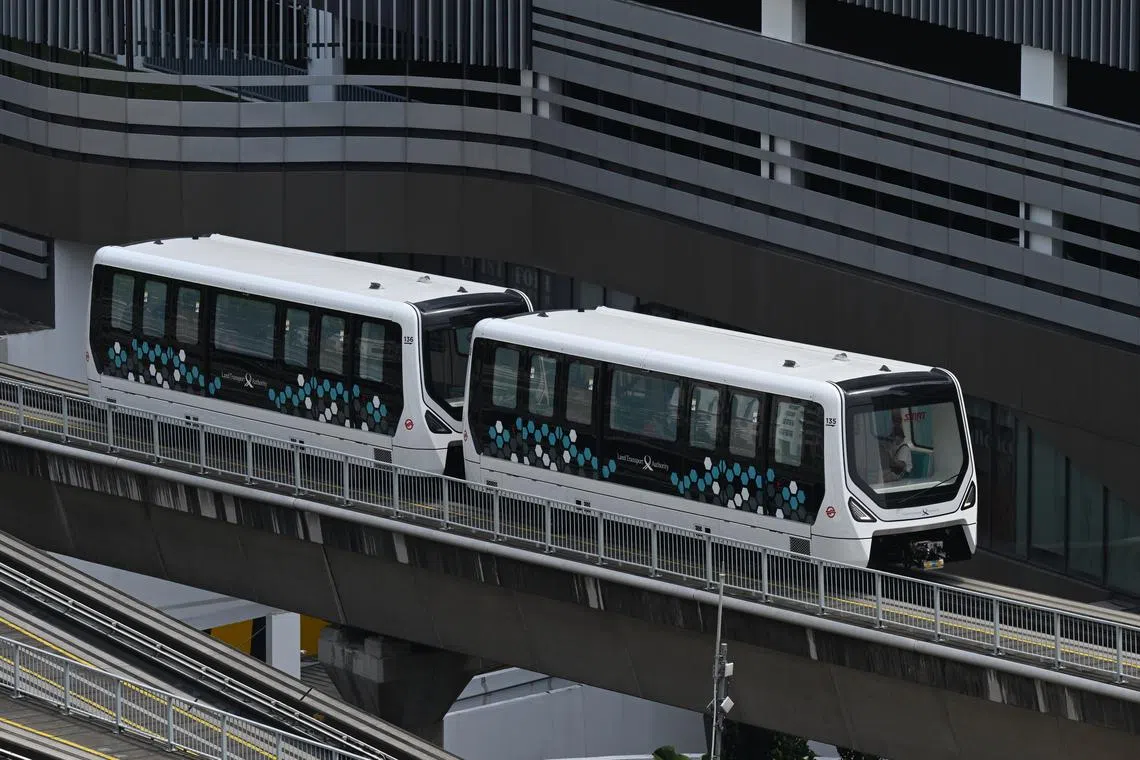Train service resumes across Bukit Panjang LRT line after power fault led to 3-hour disruption
Sign up now: Get ST's newsletters delivered to your inbox

About three hours after the fault surfaced, SMRT said traction power on the Bukit Panjang LRT was restored and regular train service was progressively resuming.
PHOTO: ST FILE
Fatimah Mujibah and Savanna Tai
Follow topic:
SINGAPORE – Train service on the Bukit Panjang LRT (BPLRT) line resumed at about 11.40am on July 3, about three hours after a power fault led to disruption at all stations.
In a Facebook update at 9.13am, transport operator SMRT notified commuters about the fault spanning all 13 stations that happened at around 8.50am. It said free regular or bridging buses were available outside the stations.
In an update about five minutes later, SMRT said its staff were on site working to resolve the issue and assisting affected commuters.
“Train services are currently unavailable across the entire BPLRT system. In-train and station announcements have been made to keep commuters informed,” it said.
In an update at 11.37am, about three hours after the fault surfaced, SMRT said traction power on the BPLRT was restored and regular train service was progressively resuming. It added that free bus services were still available.
A few minutes later, it said train service had fully resumed, and that free bus services had also ended.
When The Straits Times arrived at Bukit Panjang station at about 9.45am, about seven SMRT staff were seen informing commuters about the LRT disruption.
Singapore Polytechnic student Darryl Teo, 18, was heading to his school in Dover from his home in Segar when the LRT train he was in stopped just after Fajar station. He took one of the bridging buses to Bukit Panjang.
“I was supposed to be in school at 10.15am, but now it’s already 10am,” he said, adding that he would typically stop at Choa Chu Kang station before switching to the East-West Line to Dover.
He said that what would have been a 45-minute journey would now take him double the time on an alternative route.
Mr Mohammad Adamin, who lives in Segar, told ST that he would be late for his barista job in Lakeside.
The 35-year-old had similarly intended to take the LRT to Choa Chu Kang before switching to the East-West Line, but decided to take bus service 180 from Bukit Panjang interchange instead.
“It takes me about 45 minutes by train. But with the bus, I don’t know the traffic, so it may take me one hour,” he said.
This was the second train disruption this week, after a signalling fault at Orchard station on the Thomson-East Coast Line on July 1 led to delays between Napier and Great World stations
The 8km-long BPLRT network has a long history of reliability issues, with the most recent disruption occurring on Oct 22, 2024, during the evening rush hour.
Train service stalled between Bukit Panjang and Choa Chu Kang LRT stations and resumed only the next morning.
Initial findings showed that the breakdown was in one of the wheel assemblies on a faulty train.
Following this, the Land Transport Authority (LTA) and SMRT said train services would end an hour earlier from Thursdays to Sundays between Nov 14, 2024, and Oct 31, 2025, to facilitate renewal works.
These works include the upgrading of the BPLRT’s signalling system, and the testing of new and retrofitted light-rail vehicles.
Works to upgrade the existing signalling system on the BPLRT to a new communications-based train control system that better controls train speeds – similar to that used on MRT lines – have been carried out progressively since 2022.
LTA said it is targeting to complete the full renewal programme by the end of 2026. This was delayed by two years from 2024 due to a manpower shortage and supply chain disruptions arising from the Covid-19 pandemic.
In 2024, the average daily ridership on the LRT network, which includes the Sengkang-Punggol LRT, stood at 210,000. This was an increase of 4 per cent from the 2023 figure.

